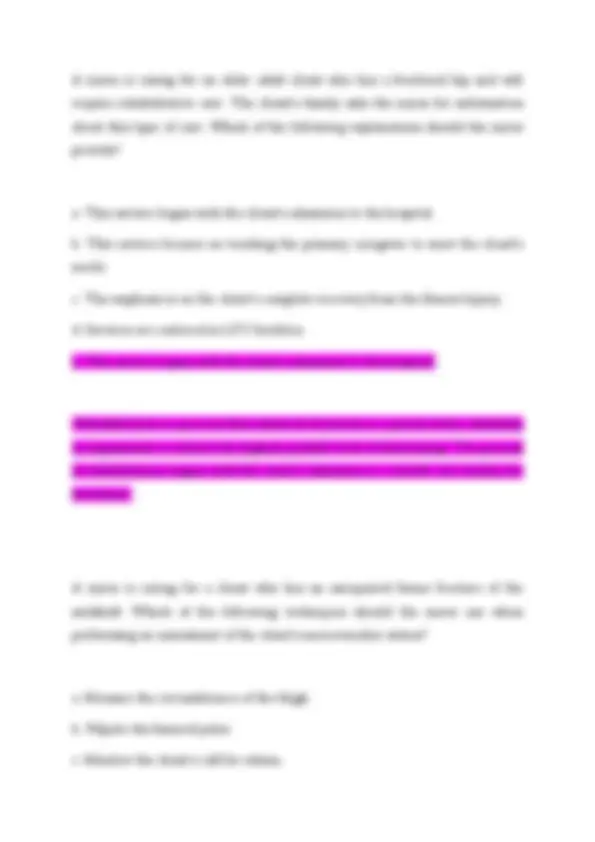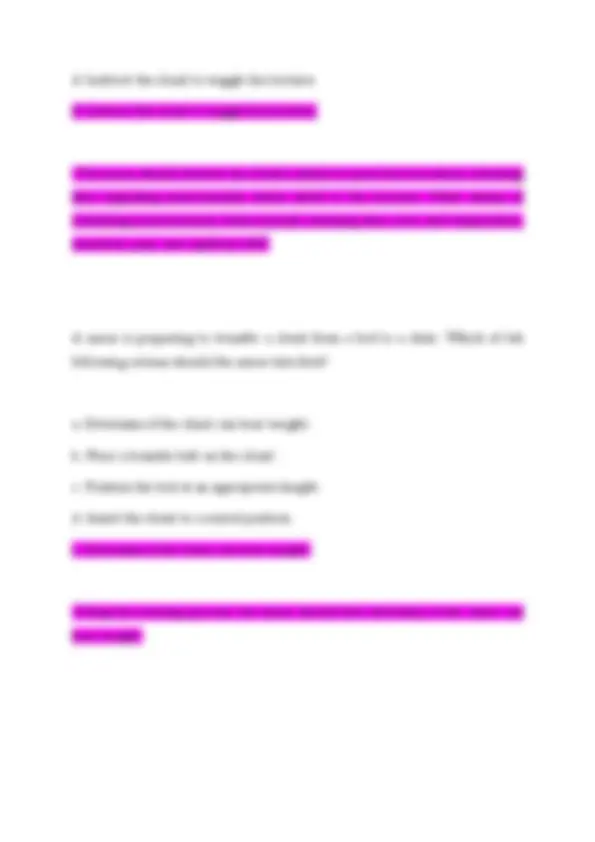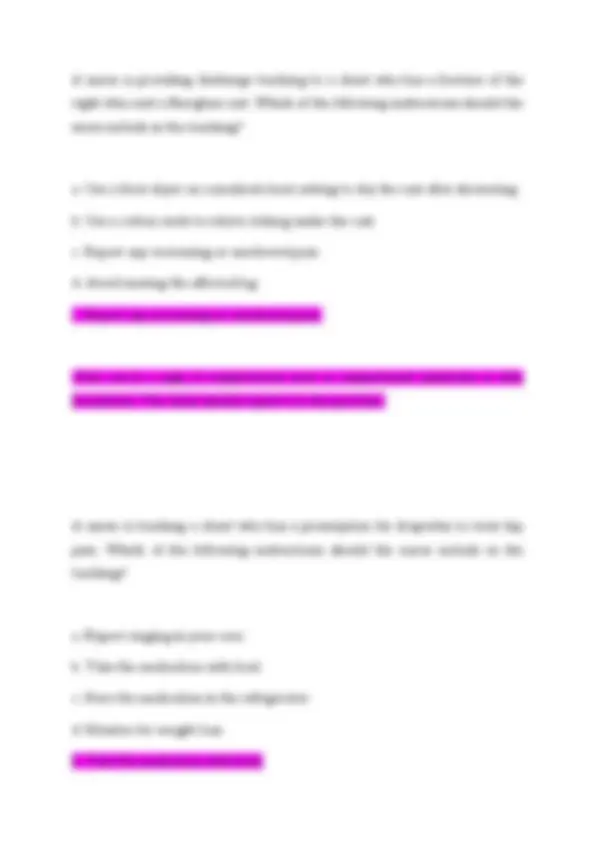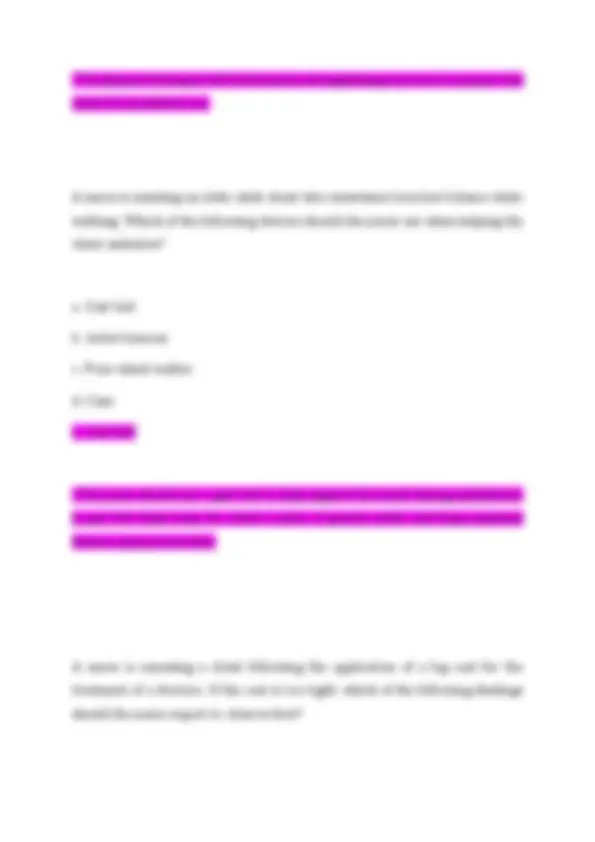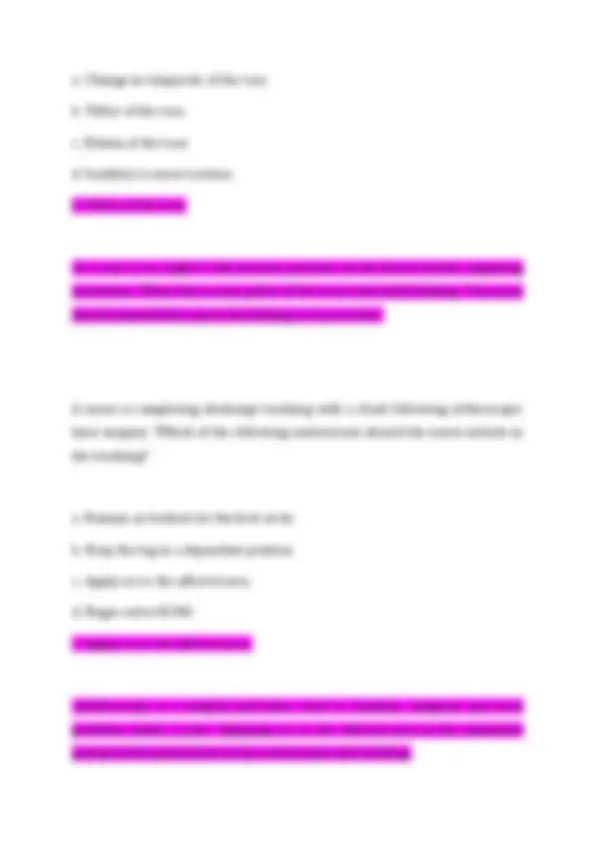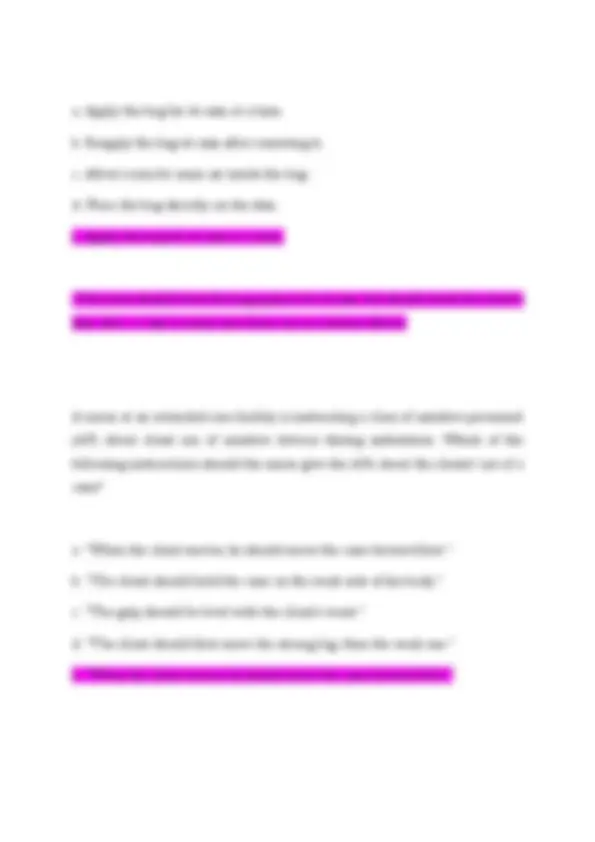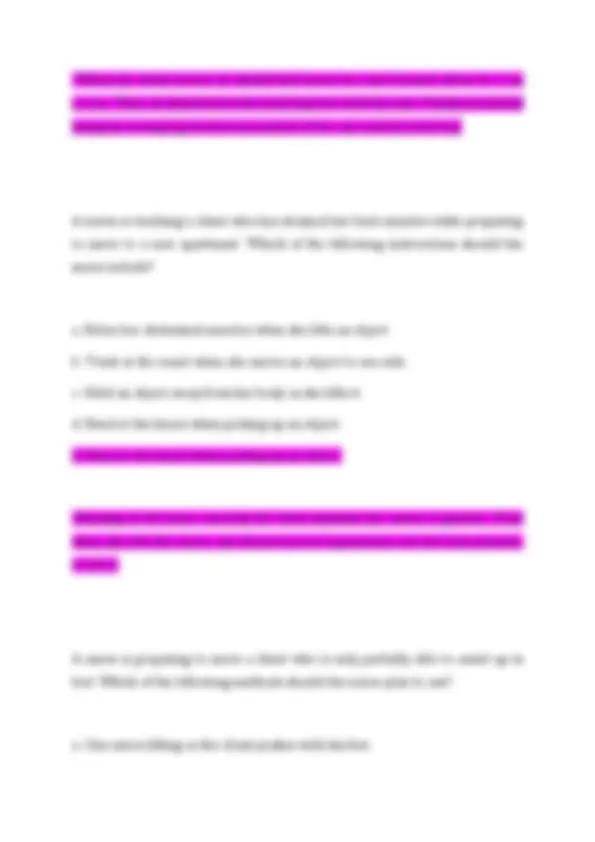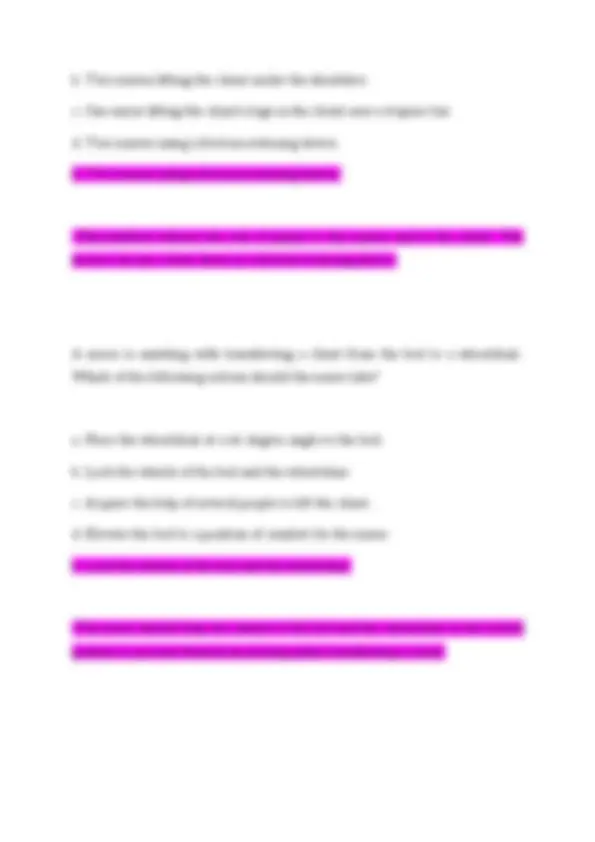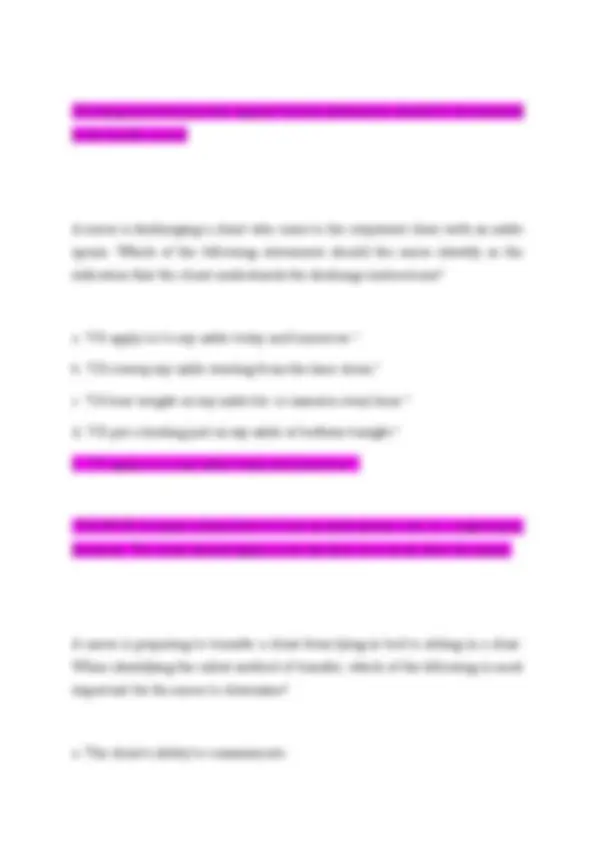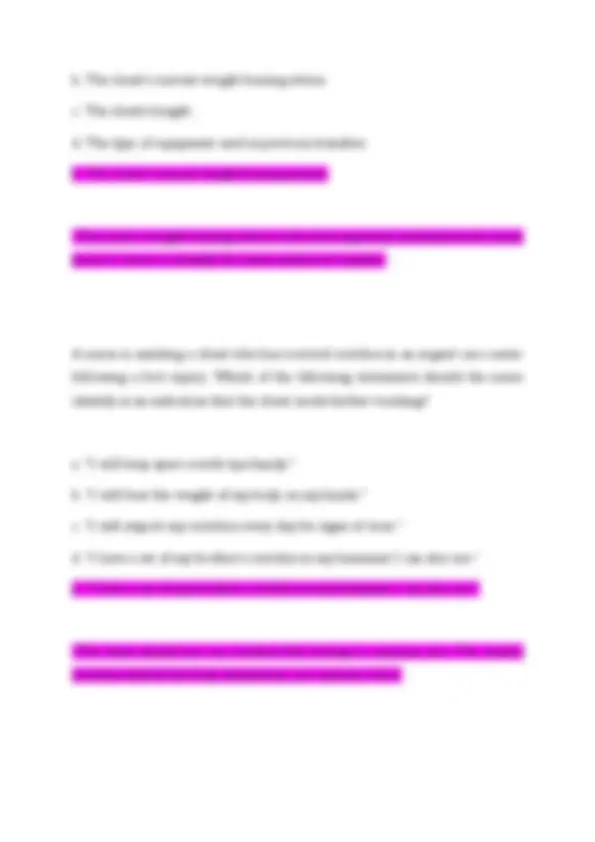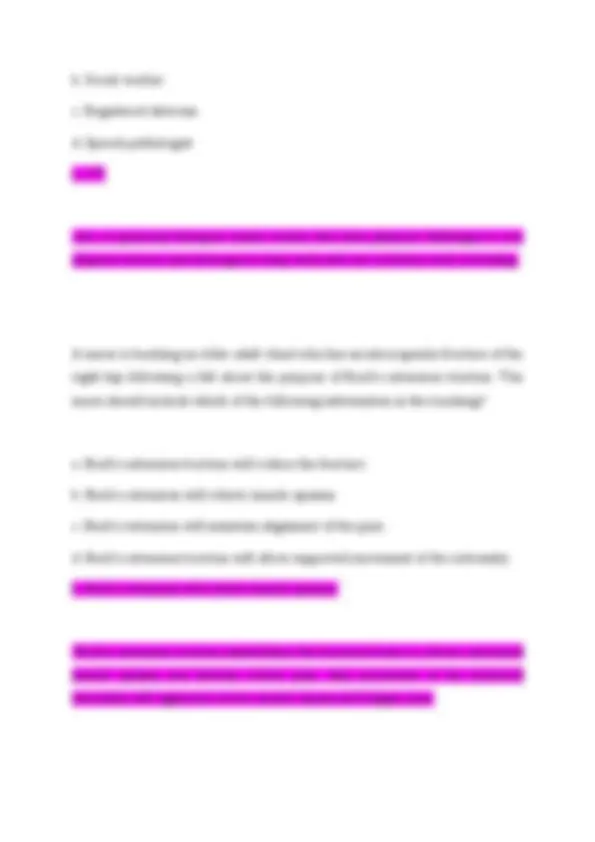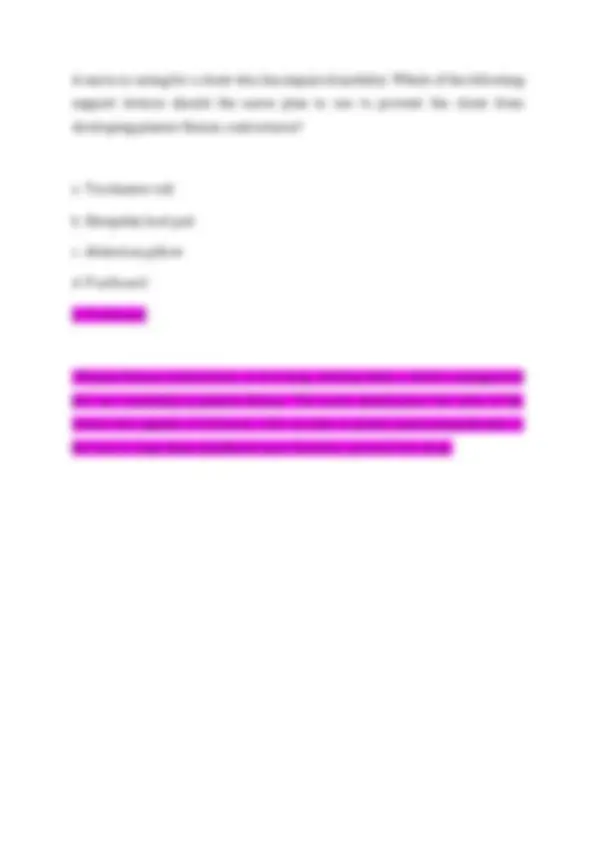Download ATI CUSTOM: MOBILITY | QUESTIONS AND ANSWERS | 2025-2026 | GRADED A+ and more Exams Nursing in PDF only on Docsity!
ATI CUSTOM: MOBILITY | QUESTIONS AND
ANSWERS | 2025-2026 | GRADED A+
A nurse is teaching a client who has a prosthetic limb due to a right below-the- knee amputation about prosthesis and stump care. Which of the following instructions should the nurse include in the teaching? a. Keep the prosthesis in direct contact with the residual limb. b. Apply a moisturizing lotion or oil to the stump daily. c. Dry the prosthesis socket completely before applying it to the limb. d. Expect some skin irritation from the prosthesis. c. Dry the prosthesis socket completely before applying it to the limb.
- The client should dry the prosthesis socket thoroughly with a clean cloth. Moisture between the socket and the stump can put the client at risk for fungal or bacterial infection and skin breakdown A nurse is caring for a client who is prescribed bedrest. The plan of care indicates that the client should perform isometric exercises every 2 hrs. Which of the following actions should the nurse take as directed by the plan of care? a. Ask the client to move her arms and legs while applying slight resistance. b. Move the client's limbs through their complete ROM. c. Have the client move each limb independently through its complete ROM.
d. Instruct the client to tighten muscle groups for a short period of time, and then relax. d. Instruct the client to tighten muscle groups for a short period of time, and then relax.
- Isometric exercises involves static (no movement) contraction of a muscle without any movement of the joint. Isometrics promote increased muscle mass, strength, and tone for clients who are on bedrest. A nurse is preparing to assist a client who can partially bear weight and is cooperative with transfer from the bed to a chair. Which of the following actions should the nurse take to maintain safety during the transfer? a. Enlist help from another staff member. b. Adjust the bed to an appropriate height. c. Use a powered standing-assist lift. d. Avoid movements that twist the spine. c. Use a powered standing-assist lift.
- Using a powered standing-assist lift will best ensure the safety of the client and the nurse.
d. Instruct the client to wiggle his tootsies. d. Instruct the client to wiggle his tootsies.
- The nurse should observe the client's ability to move his toes when collecting data regarding neurovascular status distal to the fracture. Other means of evaluating neurovascular status include assessing skin color and temperature, sensation, pain, and capillary refill. A nurse is preparing to transfer a client from a bed to a chair. Which of teh following actions should the nurse take first? a. Determine if the client can bear weight. b. Place a transfer belt on the client. c. Position the bed at an appropriate height. d. Assist the client to a seated position. a. Determine if the client can bear weight.
- Using the nursing process, the nurse should first determine if the client can bear weight.
A nurse is providing discharge teaching to a client who has a fracture of the right tibia and a fiberglass cast. Which of the following instructions should the nurse include in the teaching? a. Use a blow dryer on a moderate heat setting to dry the cast after showering. b. Use a cotton swab to relieve itching under the cast. c. Report any worsening or unrelieved pain. d. Avoid moving the affected leg. c. Report any worsening or unrelieved pain.
- Pain can be a sign of complications such as compartment syndrome or skin breakdown. The client should report it to the provider. A nurse is teaching a client who has a prescription for ibuprofen to treat hip pain. Which of the following instructions should the nurse include in the teaching? a. Expect ringing in your ears. b. Take the medication with food. c. Store the medication in the refrigerator. d. Monitor for weight loss. b. Take the medication with food.
c. "I will place an area rug at the entry of my bathroom." d. "I will place a bath seat in my shower to use when I bathe." d. "I will place a bath seat in my shower to use when I bathe."
- A bath seat can help reducing slipping and falling in the bathtub or shower. A nurse is assessing a client who is in skeletal traction. The nurse should correct which of the following findings? a. The ropes are in the center of the wheel grooves. b. The weights rest against the foot of the bed. c. The weights are equal on each side. d. The ropes are securely attached to the pins. b. The weights rest against the foot of the bed.
- Weights that rest against the foot of the bed or on the floor do not apply the amount of traction essential for maintaining alignment and immobilizing the bone. A nurse is assessing a client at a follow-up clinic visit for acute low back pain. A goal this client is to use proper body mechanics at all times. Which of the following findings indicates that the client is meeting their goal?
a. The client faces the direction of movement when sliding an object across the floor. b. When pushing an object, the client moves his front foot backward. c. When moving an object to one side, the client puts his weight on his heels. d. The client stands with their feet close together when lifting an object. a. The client faces the direction of movement when sliding an object across the floor.
- Sliding an object across the floor rather than lifting it prevents strain on the lower back muscles.. Facing the direction of movement prevents twisting his back A nurse is providing teaching for a client who is preparing for a below the knee amputation. Which of the following statements is true regarding the postoperative placement of a prosthesis? a. "You will do special exercises in advance of getting your prosthesis." b. "You will be fitted for your prosthesis at the time of your surgery." c. "A special pressure dressing will remain on to cushion your prosthesis." d. "The prosthesis will be adjustable depending on what shoe you are wearing." a. "You will do special exercises in advance of getting your prosthesis."
a. Change in temperate of the toes. b. Pallor of the toes. c. Edema of the toes. d. Inability to move tootises. b. Pallor of the toes.
- If a cast is too tight it will increase pressure on the blood vessels, impairing circulation. When this occurs, pallor of the toes is the initial finding. The nurse should immediately report this finding to the provider. A nurse is completing discharge teaching with a client following arthroscopic knee surgery. Which of the following instructions should the nurse include in the teaching? a. Remain on bedrest for the first 24 hr. b. Keep the leg in a dependent position. c. Apply ice to the affected area. d. Begin active ROM. c. Apply ice to the affected area.
- Arthroscopy is a surgical procedure used to visualize, diagnose and treat problems inside a joint. Applying ice to the affected area in the immediate postoperative period (first 24 hr) reduces pain and swelling.
A home health nurse is assessing an older adult client in the home who has decreased vision due to a history of glaucoma. Which of the following findings should the nurse identify as a safety risk? a. Electrical cords are placed along the walls. b. Scatter rugs are present in the kitchen. c. Handrails are present in the bathroom. d. Uses a microwave for cooking b. Scatter rugs are present in the kitchen.
- Scatter rugs in the kitchen are a safety hazard. The client could trip on one of the rugs and fall due to impaired vision. A nurse is providing discharge teaching to a client who has a plaster of paris walking cast on his left lower leg. Which of the following instructions should the nurse include? a. Apply ice to your foot after walking. b. A must odor is normal as the cast ages. c. There is no need to cover the cast when showering. d. Report any numbness or pain in your tootsies.
a. Apply the bag for 30 min at a time. b. Reapply the bag 30 min after removing it. c. Allow room for some air inside the bag. d. Place the bag directly on the skin. a. Apply the bag for 30 min at a time.
- The nurse should leave the bag in place for 30 min, but should check the client's skin after 15 min to make sure there are no adverse effects. A nurse at an extended-care facility is instructing a class of assistive personnel (AP) about client use of assistive devices during ambulation. Which of the following instructions should the nurse give the APs about the clients' use of a cane? a. "When the client moves, he should move the cane forward first." b. "The client should hold the cane on the weak side of his body." c. "The grip should be level with the client's waist." d. "The client should first move the strong leg, then the weak one." a. "When the client moves, he should move the cane forward first."
- When the client moves, he should first move the cane forward about 30.5 cm (12 in). Then, he should move the weak leg even with the cane. Finally, he should bring the strong leg forward and ahead of the cane and his weak leg. A nurse is teaching a client who has strained her back muscles while preparing to move to a new apartment. Which of the following instructions should the nurse include? a. Relax her abdominal muscles when she lifts an object. b. Twist at the waist when she moves an object to one side. c. Hold an object away from her body as she lifts it. d. Bend at the knees when picking up an object. d. Bend at the knees when picking up an object.
- Bending at the knees can help the client maintain her center of gravity. Then when she lifts the object, she should use her leg muscles, not her back muscles, to lift it. A nurse is preparing to move a client who is only partially able to assist up in bed. Which of the following methods should the nurse plan to use? a. One nurse lifting as the client pushes with his feet.
A nurse is caring for a client who sustained a femur fracture in an automobile accident and is placed into skeletal traction. The nurse may remove the weights from the traction device if which of the following occurs? a. The client complains of pain. b. The client develops a life-threatening situation. c. The client needs to have a x-ray of the femur performed. d. The client has to be repositioned in the bed. b. The client develops a life-threatening situation.
- Traction weights, which are to hang freely at all times, are never to be removed without a specific provider prescription unless there is a life-threatening situation. A nurse is caring for a client following a right total hip arthroplasty. Postoperatively the nurse should maintain the right leg in which of the following positions? a. Adduction b. External rotation c. Internal rotation d. Abduction a. Adduction
- When caring for a client following a total hip arthroplasty, the nurse should abduct the affected extremity to prevent dislocation, positioning the legs away from the midline. A nurse is caring for a client who has a prescription for balanced skeletal traction with a Thomas splint for the treatment of a fractured femur. Which of the following interventions should the nurse implement to prevent pressure points from developing around the edges of the splint? a. Apply lotion to the skin under the edges of the splint. b. Reposition the client to keep him from staying in the same position in bed. c. Remove the weights for a few minutes each hour. d. Apply a foot plate to the bed. b. Reposition the client to keep him from staying in the same position in bed.
- The nurse should assist in the prevention of pressure points by keeping the client properly and frequently positioned in bed. Balanced suspension traction with a Thomas splint allows for increased movement. The nurse is teaching a client about crutch walking using the 3-point gait. Which of the following statements by the nurse should be included in the teaching?
- Nursing interventions that support factual information should be documented in the health record. A nurse is discharging a client who came to the outpatient clinic with an ankle sprain. Which of the following statements should the nurse identify as the indication that the client understands the discharge instructions? a. "I'll apply ice to my ankle today and tomorrow." b. "I'll rewrap my ankle starting from the knee down." c. "I'll bear weight on my ankle for 10 minutes every hour." d. "I'll put a heating pad on my ankle at bedtime tonight." a. "I'll apply ice to my ankle today and tomorrow."
- The RICE acronym outlines how to treat an ankle sprain: rest, ice, compression, elevation. The client should apply ice for the first 24 to 48 hr after the injury. A nurse is preparing to transfer a client from lying in bed to sitting in a chair. When identifying the safest method of transfer, which of the following is most important for the nurse to determine? a. The client's ability to communicate.
b. The client's current weight bearing status. c. The client's height. d. The type of equipment used in previous transfers. b. The client's current weight bearing status.
- The client's weight-bearing status is the most important information the nurse needs to know to identify the safest method of transfer. A nurse is assisting a client who has received crutches in an urgent care center following a foot injury. Which of the following statements should the nurse identify as an indication that the client needs further teaching? a. "I will keep spare crutch tips handy." b. "I will bear the weight of my body on my hands." c. "I will inspect my crutches every day for signs of wear." d. "I have a set of my brother's crutches in my basement I can also use." d. "I have a set of my brother's crutches in my basement I can also use."
- The client should not use crutches that belong to someone else. The client's crutches must fit his body dimensions, not someone else's.

